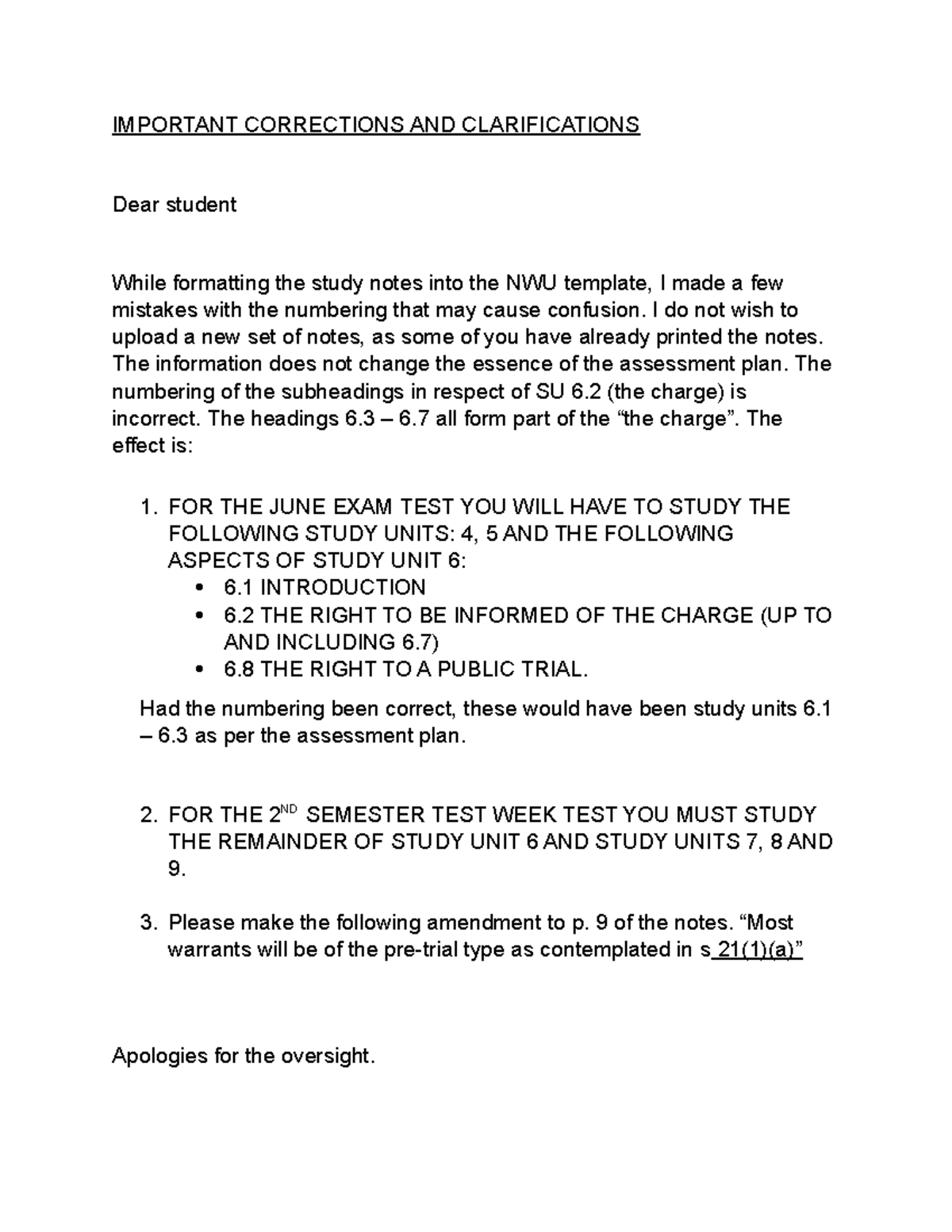How To Write Effective Corrections And Clarifications

Table of Contents
Understanding the Purpose of Corrections and Clarifications
Before diving into how to write effective corrections and clarifications, let's understand why they are essential. Accurate information is paramount, and promptly addressing errors demonstrates responsibility and commitment to your audience.
Identifying Errors and Misunderstandings
Thorough review is key. Before publishing any information, take the time to carefully review your work for potential errors. This proactive approach prevents the need for future corrections and clarifications.
-
Examples of common errors:
- Factual inaccuracies (incorrect dates, statistics, names).
- Misleading statements (statements that create a false impression).
- Outdated information (data or facts that are no longer current).
- Ambiguous language leading to misinterpretations.
-
Techniques for identifying errors:
- Peer review: Have a colleague or editor review your work for accuracy and clarity.
- Fact-checking: Verify information using multiple reliable sources.
- Proofreading: Carefully check for grammatical errors, typos, and inconsistencies.
Defining Your Target Audience
Tailoring your corrections and clarifications to your audience is critical. A technical audience requires different language and detail than a general audience.
-
Different approaches:
- Technical audiences: Use precise terminology, provide detailed explanations, and cite sources meticulously.
- General audiences: Use clear, concise language, avoid jargon, and focus on the key takeaways.
-
Considerations for diverse audiences:
- Consider linguistic backgrounds and ensure your corrections are easily understood by all.
- Use plain language and avoid overly complex sentence structures.
- Provide translations if necessary.
Crafting Clear and Concise Corrections
Once you've identified an error, it's crucial to craft a correction that is both accurate and easily understood.
Acknowledging the Error Directly
Don't beat around the bush. Acknowledge the mistake promptly and explicitly. Avoid making excuses or downplaying the error.
-
Examples of strong opening statements:
- "We regret to inform you that there was an error in our previous statement regarding..."
- "We have identified an inaccuracy in our recent report on..."
- "A correction is needed to clarify the information provided in..."
-
How to avoid defensive language:
- Avoid phrases like "we believe," "we think," or "it seems."
- Use direct and factual language.
- Focus on the correction itself, not on justifying the error.
Providing Accurate and Detailed Information
Replace the inaccurate information with accurate details. Use reliable sources and citations to back up your correction.
-
Using reliable sources and citations:
- Cite reputable sources to lend credibility to your corrections.
- Provide links to supporting documentation.
- Use consistent citation style.
-
Formatting corrections for easy readability:
- Use bolding or highlighting to draw attention to the corrected information.
- Use bullet points or numbered lists to organize information clearly.
- Break up large blocks of text to improve readability.
Maintaining a Professional Tone
Maintain a professional and respectful tone throughout your corrections and clarifications. Avoid inflammatory language or personal attacks.
-
Examples of professional vs. unprofessional tone:
- Professional: "We appreciate you bringing this to our attention and are committed to providing accurate information."
- Unprofessional: "That's your fault for misinterpreting what we said!"
-
Addressing potential criticism constructively:
- Acknowledge concerns and address them directly.
- Show willingness to learn from mistakes.
- Demonstrate transparency and accountability.
Strategically Placing Corrections and Clarifications
The placement of your corrections and clarifications is just as important as their content. Ensure they are easily visible and accessible to your audience.
Choosing the Right Platform
Correct information on the same platform where the original error appeared.
-
Considerations for different platforms:
- Website: Post a prominent correction near the original content, or create a dedicated "Corrections" page.
- Social media: Issue a public correction on the same social media platform where the original post appeared, tagging relevant accounts.
- Print: Publish a correction or clarification in the next issue of the publication.
-
Using appropriate hashtags and tags:
- Use relevant hashtags to increase the visibility of your correction on social media.
- Tag relevant accounts or individuals to bring the correction to their attention.
Ensuring Visibility and Accessibility
Make your corrections easy to find. Don't bury them!
-
Using prominent placement on websites:
- Place corrections near the original content.
- Use clear and concise headlines for corrections (e.g., "Correction: [Original Headline]").
-
Using clear and concise headlines for corrections:
- The headline should clearly indicate that the text is a correction.
- It should briefly describe the nature of the correction.
Documenting Corrections for Future Reference
Maintain a record of all corrections and clarifications for future reference.
-
Creating an internal log of corrections:
- Keep a detailed record of each correction, including the date, the original error, the corrected information, and the platform where the correction was published.
-
Using version control for online documents:
- Utilize version control software to track changes to your documents and ensure accurate record-keeping.
Conclusion
Writing effective corrections and clarifications is about more than just fixing mistakes; it's about maintaining trust and demonstrating accountability. By acknowledging errors directly, providing accurate replacements, and strategically placing your corrections, you can mitigate the impact of misinformation and safeguard your reputation. Remember to focus on accuracy, clarity, and professionalism in all your communications. By following these steps, you can master the art of writing effective corrections and clarifications, safeguarding your reputation and ensuring the accuracy of your information. Start improving your communication strategy today by implementing these techniques for all your future corrections and clarifications. Accurate corrections and effective clarifications build a stronger foundation of trust with your audience.

Featured Posts
-
 Las Vegas To Host Ru Pauls Drag Race Live 1000th Show Livestream
Apr 30, 2025
Las Vegas To Host Ru Pauls Drag Race Live 1000th Show Livestream
Apr 30, 2025 -
 Finansoviyat Uspekh Na Turneto Na Bionse Danni I Fakti
Apr 30, 2025
Finansoviyat Uspekh Na Turneto Na Bionse Danni I Fakti
Apr 30, 2025 -
 Ben Affleck Films Intense Shootout Scene With Gillian Anderson In New Movie
Apr 30, 2025
Ben Affleck Films Intense Shootout Scene With Gillian Anderson In New Movie
Apr 30, 2025 -
 House Explosion And Fire In Yate Live News And Updates
Apr 30, 2025
House Explosion And Fire In Yate Live News And Updates
Apr 30, 2025 -
 Obrushenie Gorki V Tyumeni Postradavshie Otkazalis Ot Pomoschi Vlastey
Apr 30, 2025
Obrushenie Gorki V Tyumeni Postradavshie Otkazalis Ot Pomoschi Vlastey
Apr 30, 2025
